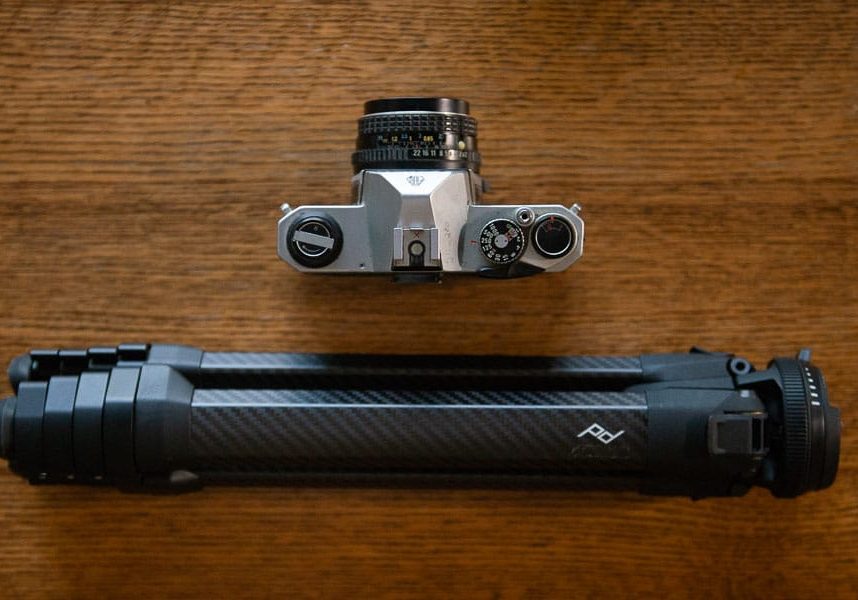
Peak Design Travel Tripod Review
This Peak Design Travel Tripod review delves deep into what might be the most technological advanced tripod design ever seen. Is it worth the money though?!
Shotkit may earn a commission on affiliate links. Learn more.
Peak Design has been rethinking the camera accessory market for many years now. You’ve probably already seen their other highly innovative products on the market!
Well, for many years they’ve been secretly brainstorming their most innovative, impressive, and apparently most complex product to date: the Peak Design Travel Tripod.
Instead of just putting their sticker on the same knock-off tripod design that almost every other new brand has been copying for years now, these folks have redesigned this travel tripod from scratch.
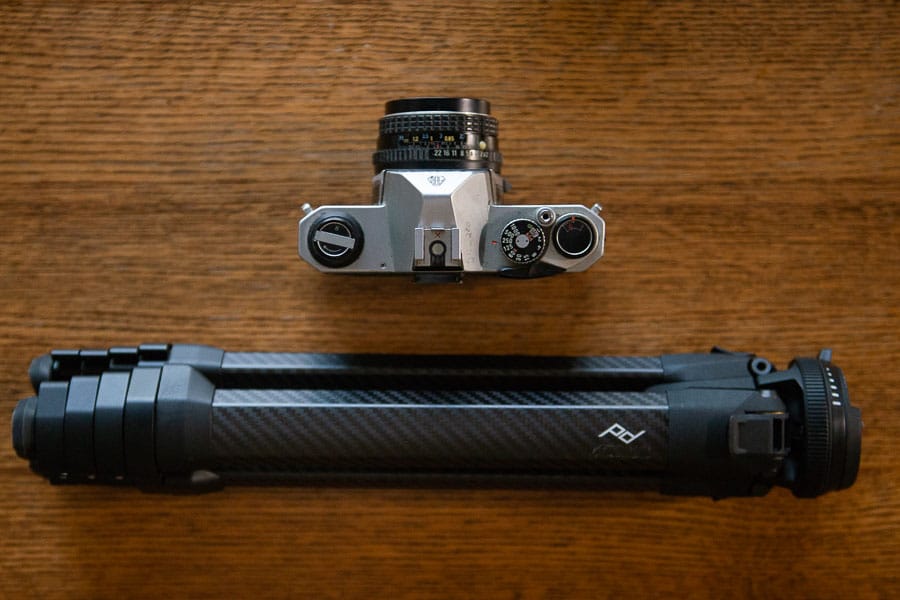
Revolutionary design with useful, well-implemented features. Best all round - highly recommended.
Literally, everything about it is something I’ve never seen before. It’s been a long time since I had this many instances of thinking, “What the heck? This is genius!”
To be honest, when I first heard that another travel tripod was headed my way for review, I groaned. I’ve lost count of how many cheap tripods I’ve broken over the years. Travel tripods, in particular, are usually way too short, very wobbly, and not even lightweight!
It seems that for most tripod makers, the word “travel” has focused on the one dimension- length when collapsed. But, if a tripod is still short when fully extended, not to mention very wobbly and kinda heavy, then I’m not lugging it up a mountain!
So, was I wrong to roll my eyes at the thought of yet another dinky little travel tripod? Indeed, this one is downright tiny. And yes, I was very, very wrong.
Peak Design Travel Tripod Review Criteria
- Compact, space-saving leg design
- Very well built
- Concealed mobile stand
- Ingenious ball head design
- Fast Deployment
- Rigid and strong
- Expensive
- Could be lighter
Reviewing a tripod might seem very simple and easy. Does it work well? How does it feel? Is it expensive or affordable? Actually, there’s a lot more to it…
To make a long story short, I’ve lost count of how many tripods I’ve used that felt sturdy at first, did their job, and seemed affordable, …yet they broke within 6-12 months, sometimes catastrophically.
For those of you who have never trusted your expensive camera and lens to a tripod, “catastrophic failure” is not a phrase you ever want to hear.

The Peak Design Tripod is almost as short (and a whole lot lighter than) a full-size DSLR & lens, which it can easily support
So, now that I’ve got your attention, here is exactly what I’ve learned to look for in a tripod’s design, and what to test rigorously in the field, in order to determine for sure whether or not it’s a good product.
Specifically, the review categories I use are as follows:
- Leg locks & center column joints
- Overall stiffness and “indestructibility”
- Size – height, weight, & portability
- Overall value for the money
Before we dive in, here are the specs:
- Price: $599.95 (carbon fiber; Aluminum: $349.95)
- Max Height: 60″ (152 cm)
- Min Height: 5.5″ (10 cm)
- Compact Length: 15.5″ (39 cm)
- Max Load Capacity: 20 lbs (9.1 kg)
Build Quality of the Peak Design Tripod

The carbon fiber version looks great!
Right away, I’m impressed by the fact that the Travel Tripod feels strong and sturdy. Its size is deceptive – this thing is built tough, and it has a bit of heft for such a small item.
That’s probably because, unlike most other tripods, there is essentially no empty space at all in between the legs or the head; it is the very definition of space-saving design!
But, don’t let the word “heft” fool you. The Peak Design Tripod weighs in at just under 3.5 lbs (1.5 kgs) including its head, which is well into the zone of “lightweight“.
Really, it’s the visual of such a tiny item that throws you for a loop. When the Travel Tripod is fully opened/extended, somehow, just looking at it while holding it you get the exact opposite feeling- this tripod weighs almost nothing!
I can’t name it the most “ultralight” option of all, however, since there are tripods in the 2 lb range. Most of those tripods are terrible though, and you’ll want to avoid them. Only a select few ultralight tripods are worth the money, and they’re either extremely expensive, or significantly bigger, or a significant compromise on stiffness and/or height.
Simply put, the Peak Design Travel Tripod strikes a great balance between being lightweight, compact, strong, and durable.
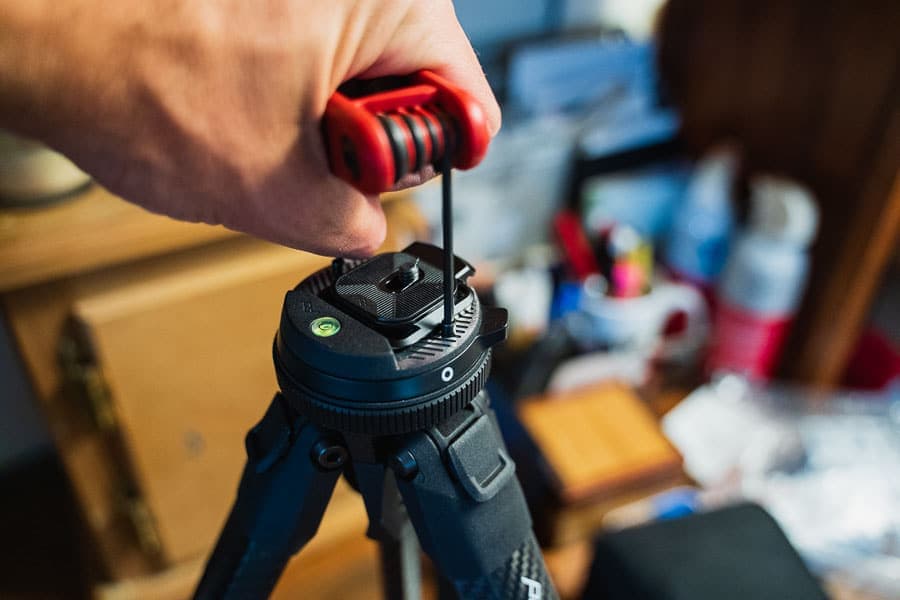
Since I use all kinds of different tripod plates, I immediately grabbed an Allen wrench set and removed these safety pins. (An Allen key that fits these pins is included, too. It’s hidden in a secret pocket on the tripod bag!)
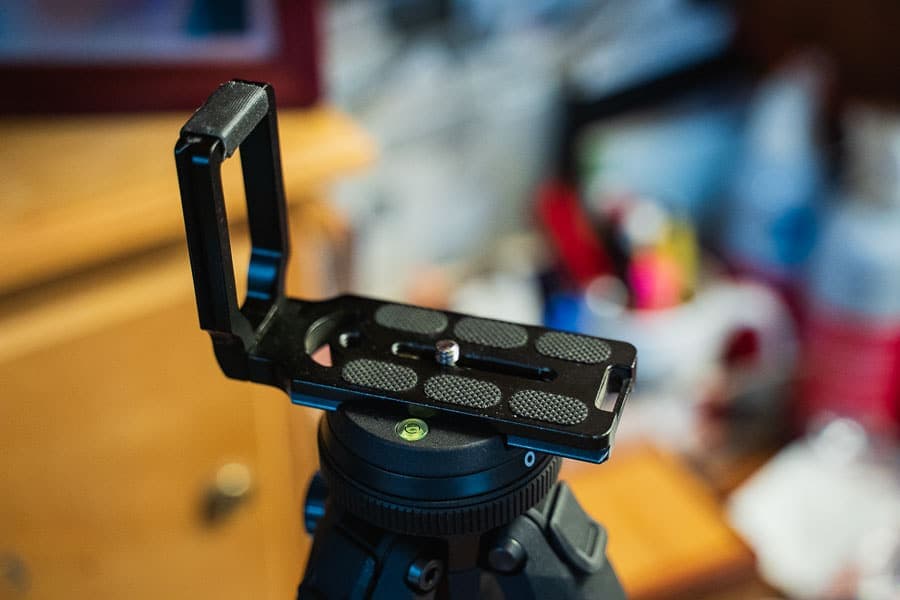
…Now the tripod head is ready for any and all of my Arca-Swiss Plates and feet!
Its materials and workmanship are definitely superior to all of the other generic, knock-off brands out there that re-package the same basic tripod design.
This is a tripod re-imagined from the ground up.
Not only are the Peak Design Tripod’s legs, base, and center column a unique overall shape that allow it to be so compact, but the most prominent elements of design, the leg angle stem and the ball head, are downright brilliant.
(Side note: the team who designed the ball head also designed the Mobile Tripod by Peak Design.)
Tripod Height

Max Height, center column extended: 60″ Min Height, center column un-screwed: 4″
How tall can a tripod hold your camera, safely and steadily? That’s a very important question that some new photographers forget to consider when shopping for a tripod.
With a travel tripod, all that matters is that it’s lightweight and portable, right? Wrong. Because, if you have to hunch over to look through your viewfinder or even to get your face close to the camera’s rear LCD, that can be a problem. Bad posture is never a good thing!
Thankfully, the Peak Design Tripod, despite being one of the tiniest tripods I’ve ever used, it’s also surprisingly tall. It rises to 60″ (150 cm) which is very impressive for a tripod that packs down to just 15.4″ (39 cm).
As someone who is 74″ tall (188cm), it’s not quite tall enough for me to put my eye to the viewfinder. Then again, most travel tripods aren’t. With articulated LCDs appearing on almost every camera now, 60″ is indeed tall enough for most people.
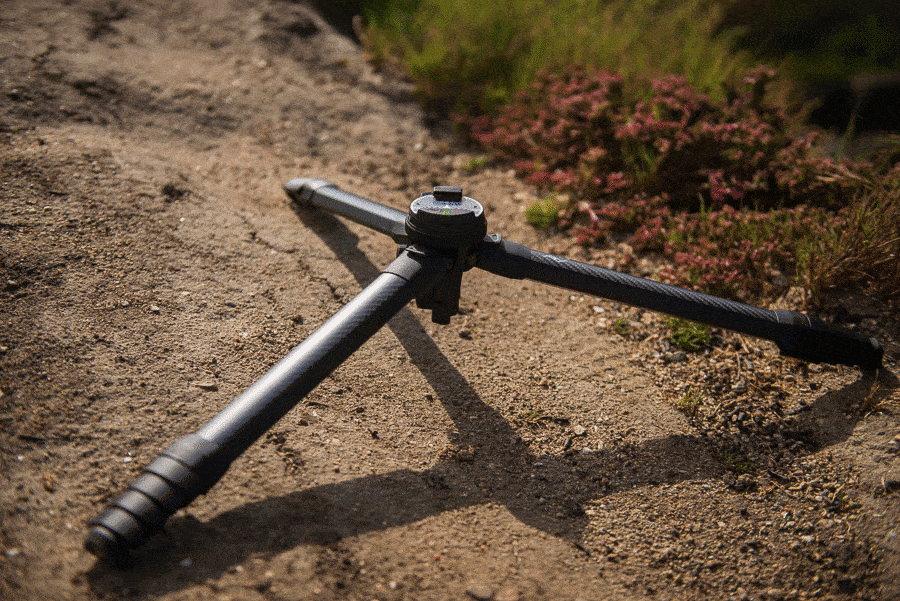
The lowest height of 4″ is possible with the center column unscrewed (provided Allen wrench is required)
I will say, however, that one thing I miss is the medium leg angle which allows you to put the legs halfway between “as tall as possible” and “totally flat”.
Most tripods have three total leg angles, and I’ve grown very accustomed to it. However, this really won’t be a deal-breaker for most photographers. Just don’t leave your camera unattended in high winds.
Tripod Leg Locks & Joints

The leg lever locks might be a bit claw-like, but the leverage they offer will make them painless to operate in cold temperatures.
I must admit, from the pre-release pictures that I saw of the Peak Design Tripod before it was officially announced, the leg locks and joints were my main concern.
There are five leg sections per leg, which means four locks per leg, and they’re lever-lock, not twist-lock. For me as a landscape photographer who uses tripods very heavily, that seemed like two strikes against it.
To my surprise, the legs are some of the stiffest and strongest I’ve ever encountered, and the locks are strong, tight, and very easy to use.
Their large, hooked design makes them extremely easy to unlock and lock all at once when the legs are compacted, and easy enough to lock and unlock when the legs are extended.
As a bonus, the leg locks do have an easy-access Allen key tightening screw, which many lever-lock tripod legs do not have.
(By the way, in case you’re anything like me and don’t fully read instructions before taking gear out into the field to use it, the included Allen key is “hidden” in a secret pocket on the tripod bag.)

In case you’re wondering where the Allen key is hidden, here it is!
Really, the crowning achievement to me is the low profile of not just the leg lock joints, but also the rest of the levers and clamps too.
They’re all so flush with everything else that it adds up to make a huge difference in the overall portability of the Peak Design Tripod.
There are no knobs sticking out anywhere, even on the camera plate clamp like there always have been for Arca Swiss clamps. Well done, PD!
Another neat and original feature and something I’ve never seen implemented before is hidden away in the centre column of the Travel Tripod – namely a fold-out stand for securing a smartphone to the tripod ball head.
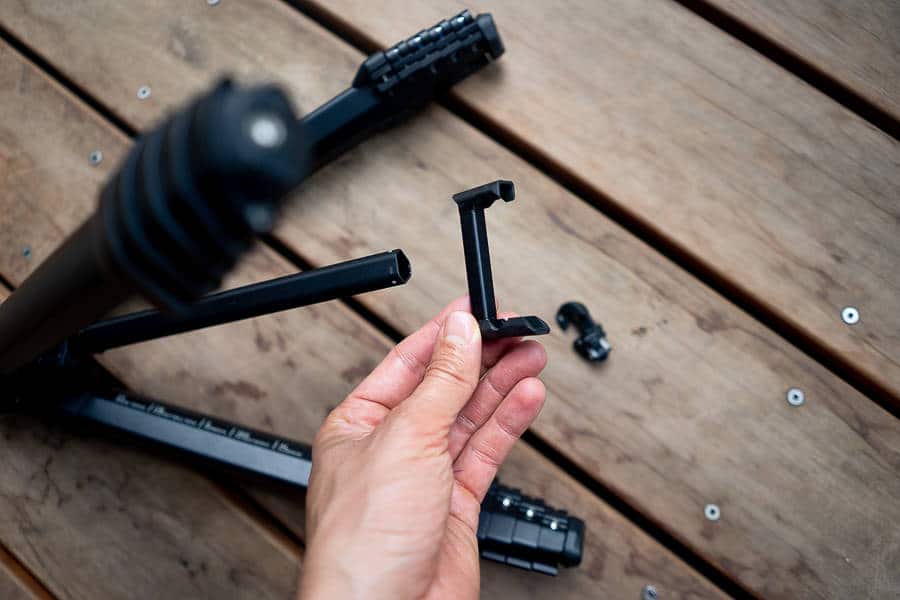
Hidden away in the centre column is a neat little smartphone stand.
For photographers who like to capture the occasional smartphone selfie video, or perhaps even a time-lapse or night photography long exposure to share quickly over social media, it’s a useful little feature.
To deploy it, you just twist the hook attached to the base of the centre column and pull out the clamp, which is folded up and suspended magnetically within the column. Then you clip it to the ball head, just as you would the base plate on your camera, Storing it away is just as fast and simple.
This is the kind of smart, lateral thinking that Peak Design is so well-known for, and yet another small but useful function that makes this tripod stand out from all the others on the market.
Tripod Ball Head
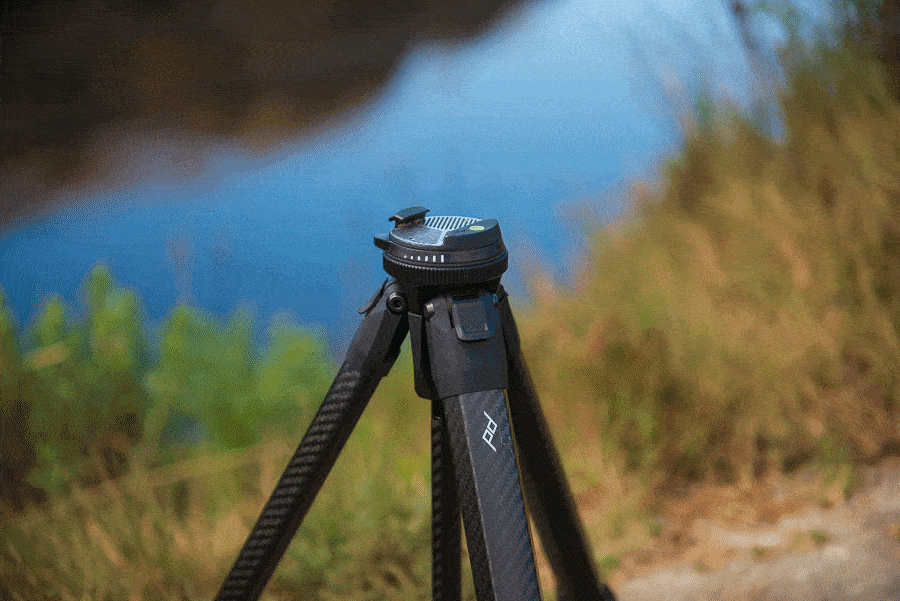
Is the ball head the center column, or is the center column the ball head? They are essentially one and the same.
The head of the Peak Design Travel Tripod is definitely the most unique, dare I say bizarre, and genius things about it. In fact, it’s totally integral to the tripod itself.
Peak Design has completely re-imagined the industry status quo: “you can buy legs and a head separately”. These two parts could not possibly be more intertwined.
The center column itself is part of the head; it’s topped off with a ball, and the clamp sits right on top.
When completely collapsed, the clamp itself slips down in between the leg angle platform. It is this final design characteristic that completes the “no empty spaces” compact design.
You can see more about how the ball head works in the video below:
But, does the ball head actually work well? First, the clamp’s grip itself is very strong. It is ready to keep even a full-frame DSLR with a big flagship f/2.8 zoom perfectly in place.
Of course, you have to crank the locking mechanism down a little aggressively if your body and lens begin approaching the maximum rated weight limit.
On the other hand, all those lightweight mirrorless cameras and crop-sensor systems that many photographers are adopting will feel perfectly at home on this rock-steady platform.
My only critique is that this design inherently forfeits a separate panning knob for the ball head. The center column’s triangular shape means you can’t even cheat by loosening it slightly with the center column down.
Overall, though, it’s a compromise that I’m totally willing to make for the benefit of such a strong, stable tripod being so utterly tiny when collapsed.
Performance
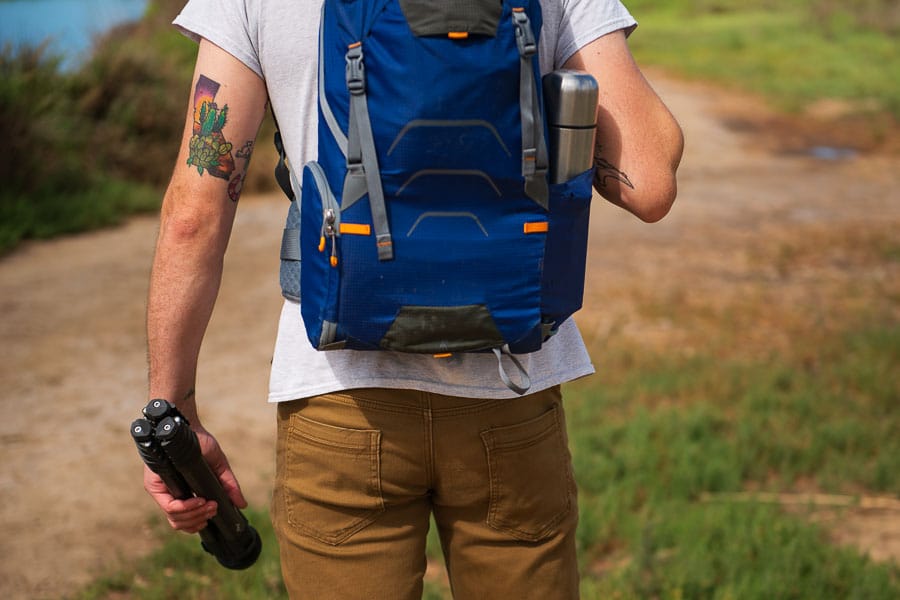
The Peak Design Travel Tripod is slimmer than, and weighs less than, my large coffee thermos!
How do you judge a tripod’s performance? It’s all about whether or not you can actually get sharp photos at slow shutter speeds!
So, just like I would review a lens or a camera, I ask myself: “do the images look good?”
Again, Peak Design has come up with one of the stiffest, most high-performance travel tripods that I’ve ever used.
Despite its odd leg and head design, the verdict comes easy: Not only does the tripod do a great job of holding a camera perfectly still, but the highly unique ball head design still affords a decent amount of precision and easy operation.
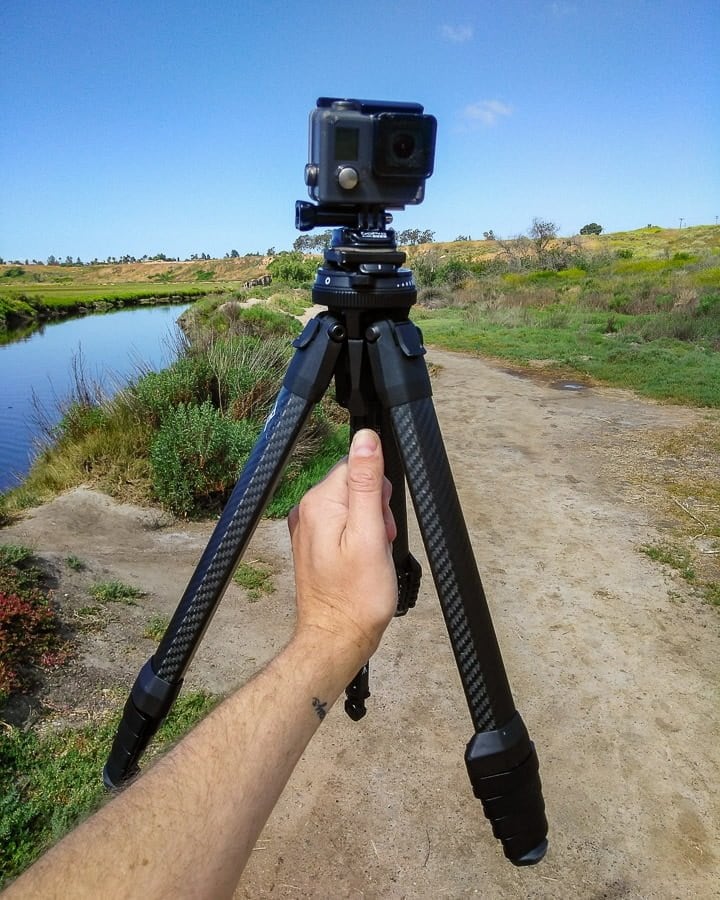
By the way, the Peak Design Travel Tripod makes a great GoPro vlogging “battery-free gimbal” ;-)
I will say, however, that the ball head is not without its compromises. In addition to the lack of a dedicated panning knob, the clamp itself does create a slight risk of changing your composition unintentionally when locking the head down.
To Peak Design’s credit, it’s actually surprisingly good at keeping your composition exactly how you set it, but the lock-down action itself does require a little more attention than a traditional ball head.
Anyways, I just can’t get over how compact and yet tall and strong the Travel Tripod is. If anything, the design is so compact that the tripod’s heft throws you for a loop at first.
Opened and extended, though, all of a sudden it feels feather-light and yet still strong and tall. It’s definitely ready for a full-frame DSLR and standard pro lenses, but it’s also compact and portable enough that it’ll make a fantastic, solid platform for your lightweight mirrorless and/or crop-sensor system too.
Price & Value | Carbon Fiber VS Aluminum
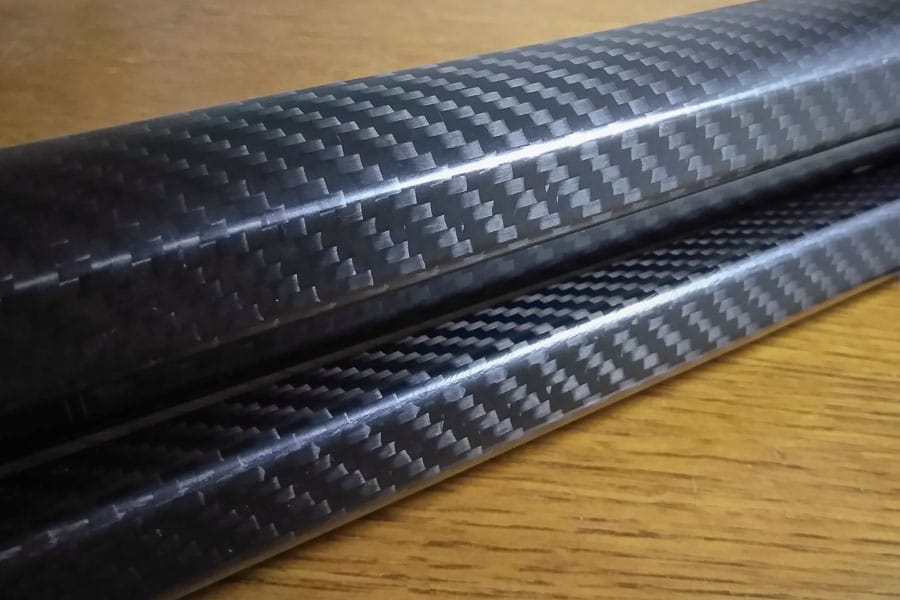
Carbon fiber looks gorgeous, sure, but there’s a lot more to it than that.
The Peak Design Travel Tripod will set you back $599.95 for the carbon fiber version, and $349.95 for the aluminum one.
So, are these tripods good value, when you can find “junk” tripods (in my opinion) for about half as much? Absolutely, because those junk tripods will break very quickly, whereas this product could last you a lifetime if you take decent care of it.
The aluminum version is already rather light however, at just 3.44 lbs (1.56 kgs) compared to the carbon fiber model’s 2.81 lbs (1.27 kgs). So, you might really wonder if the carbon fiber version is worth the higher price tag.
It’s definitely worth considering the carbon fiber Travel Tripod model – there’s more to carbon fiber than just its weight. Carbon fiber is also much stiffer and stronger than aluminum. This absolutely can translate to sharper images, with heavier camera gear.
Consider your kit, and the shooting conditions: Light breeze? Carbon fiber will resist the tendency to experience a “vibrato” that totally ruins fine image detail. Super-telephoto lens? Carbon fiber will allow your tripod to settle down more quickly, with or without wind, so that you can use your camera’s simple 2-3 sec exposure delay mode (self-timer) to get pin-sharp images at super telephoto focal lengths.
Lastly, if you shoot in extremely cold environments a lot, holding carbon fiber legs will keep your hands much warmer than metal legs, even through thin gloves!

For Comparison- Left: Slik 700DX “heavy duty” tripod Center: Peak Design Travel Tripod Right: Manfrotto Tabletop Tripod.
So, both the aluminum and carbon fiber versions of the Peak Design Travel Tripod do present a good value, thanks to their overall quality, amazing design, and their ability to keep your camera perfectly steady even at a decent height.
If you just can’t afford the carbon fiber model, simply ask yourself how often you need to use your tripod, and how demanding are you going to be of it.
Will you be shooting in tough conditions, with larger, heavier telephoto lenses? Just keep saving for the carbon fiber model.
Or, will you be shooting more casually, with a compact lightweight setup at normal focal lengths? You’ll definitely be fine with either tripod.
No matter what, you’ll be getting sharper images, plus a less frustrating overall shooting experience and a much longer lifespan, out of a Peak Design Travel Tripod than any other cheap tripod out there, aluminum or carbon fiber.
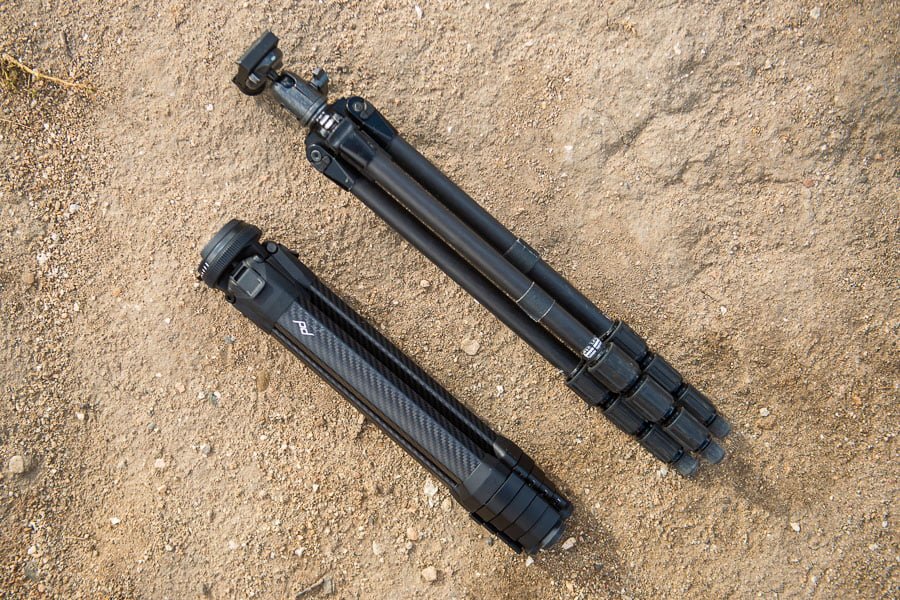
For Comparison: My favorite backpacking tripod, the (discontinued) Slik 614 CF, which weighs only ~2.1 lbs with a head, is indeed significantly larger than the Peak Design Travel Tripod. Also, it is a little less stiff and only marginally taller.
What if you’re looking for something even more lightweight, though? While most no-name or newcomer brand tripods get a big thumbs down from me, I do recommend the ~2 lb range backpacking/hiking tripods from Slik, a name brand, such as the Slik Sprint and Lite series (see my full camera tripod guide for more details).
You trade a fair amount of overall build quality by going with a tripod that weighs in at under 2 lbs, of course, but for those hikers and travelers who count every ounce/gram, it’s a good option to have.
Get an exclusive Peak Design x Shotkit Discount Code:
Final Words

In case you’re wondering, yes, that’s a 15″ MacBook Pro. The Peak Design Travel Tripod is THAT small!
Simply put, this is the best compact travel tripod around, especially if space in your bag(s) is very precious. The Peak Design Travel Tripod is a champion of portability. No other tripod is this low-profile yet also this strong and tall.
Yes, on certain occasions I will instead opt for my tripods in the ~2 lb range, like when I need to carry 2-3 tripods up a mountain. However, for most people who travel with just one tripod, this could be your best choice.
It’s not just made for travel, of course. The portability means the Travel Tripod is also a great everyday tripod that you can slip into your camera bag, rolling case, or almost anywhere.
It’s the perfect tripod for photographers who don’t necessarily use a tripod all the time, but would likely not even bring one if it were too big and unwieldy.
If you can’t afford the carbon fiber version, don’t worry, the aluminum version is a great choice too, for nearly half the price. Either way, this is definitely my new favorite ultra-portable travel tripod.

Revolutionary design with useful, well-implemented features. Best all round - highly recommended.





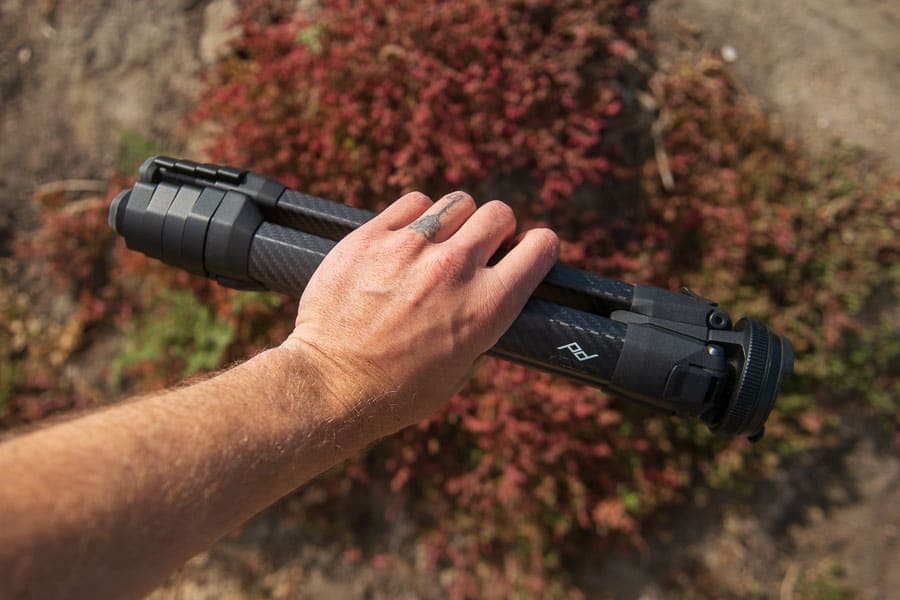


Photography is fueled by my love for light and my desire to create meaningful connections.This is very useful and efficiency content, mysterious and surrealistic effect you created.
Thanks for sharing your article with us.
Regards,
Ryan
The Peak Design Travel Tripod seems like a game-changer for anyone serious about photography. Its innovative design and practical features make it stand out from the typical flimsy, heavy, or too-short travel tripods we often see. The compact, space-saving leg design, along with the ingenious ball head, truly set it apart. While it’s on the pricier side, the build quality and ease of use could justify the investment for frequent travelers or photographers who need reliability. Highly recommended!
Peak carbon tripod panning solution.
Hi: You mentioned the issue of not being able to do a pan because the head can’t rotate. Here’s my solution; inexpensive and easy.
I use the Peak standard plate.
Neewer Metal 60mm Quick Release Plate
https://www.amazon.com/gp/product/B07RS348PB/ref=ox_sc_act_title_1?smid=A39F69IW77H648&psc=1
The Neewer Camera Panoramic Panning Base
https://www.amazon.com/gp/product/B07PB1MX35/ref=ox_sc_act_title_2?smid=A2DLO1SS82Y0QI&psc=1
When sandwiching all 3, this piece of kit adds maybe 1” of height, which is not an issue if your only primary requirement is rotation. You can’t leave it attached to the tripod as it won’t fit in the carry case, but it’s small enough to easily transport to your location and quickly attach to the tripod. Works great!
Thanks for the tips, Chris!
Hi, do I understand correctly that one can’t use the tripod head to shoot panorama, which require several horizontal shots? thanks
I think you’re right about both tripods offering good value. I love this tripod. I got the aluminum version and I really think it’s the better buy. If you need more stability attach a camera bag to the center column hook. I actually put the tripod in my camera bag so people don’t know I’m carrying a tripod even though this thing hardly looks like a tripod. Check out this article I wrote about it: https://nextinphotography.com/the-best-tripod-for-people-who-dont-like-tripods/
Thanks for sharing your review, David!
Hi there,
Do you think the aluminium is still an acceptable model to go for or will I regret not going for the carbon fibre?
The weight seems quite high versus some other travel tripods which I’ve seen for ~1000g like the Slik Lite range.
I never use a tripod right now due to lugging the size/weight but I have wanted to get one for night shots and taking photos with me AND my family in (hurray)
I was curious what your opinion is versus these options as well, what do you think?
Both versions are definitely not the lightest travel tripods available. I owned both and sold the aluminium, simply as I prefered the look and feel of the CF!
How pathetic that you don’t publish critical comments about your articles. You deleted my comment from a few days ago because it didn’t fit this article’s narrative. I have screenshots and will be tweeting those and paying them around on Facebook to let people know what kind of hacks you are.
Calm down Josh!! Our site has just come back online, after being broken for 24 hours – google it if you like. We lost a lot of comments and 6 articles, which we’re currently rebuilding. Feel free to comment what you said again, and as long as it’s not offensive, we’ll publish it, just like we do with all reasonable comments. Sounds like you’re pretty angry though, so maybe this isn’t the best space for you to vent. All the best.
hey there ….
is the aluminum version of the peak design tripod suitable for slow shutter speeds in running water … if the tripod is now in running water, is it suitable for slow shutter speeds?
Hello, please how did you mount the gopro on the Peak Design tripod ? Would you list these accessories please ?
Thanks for sharing
Hi Bryan,
I know you saw my reply to your FB message, but I thought I’d reply here as well, for the benefit of others who may read this review:
I used one of the Gopro adapter plates that has double-sticky tape on it, the flat one, and I stuck it to the smallest Arca-Swiss plate I could find. Kinda about the size of a Peak Design standard plate, but just slightly larger and metal surfaced so the double-sticky tape can get a more secure grip.
Hope this helps anybody else who is wondering!
It’s been a while since this review was published so I am hoping someone will see this comment and, perhaps, offer some insight.
Will the head of the PD Travel Tripod accept non-PD Arca-Swiss plates? I have Arca-Swiss L-brackets and the PD “Capture” clip does NOT accept regular A-S plates, only the little PD plates which go loose too quickly.
Can anyone help me out? Thanks.
As far as I can tell, most A-S plate should work with the tripod’s ball head. In the case of longer A-S plates (star trackers, L-brackets, etc), the ball head’s safety pegs can be removed with the provided allen key to accommodate longer plates. I hope that helps!
Thanks Matt, for such a thoughtful review. Really appreciated the effort you put into explaining why someone should consider the aluminium tripod vs the carbon-fiber. I have read a number of other reviews and no one else has really addressed this issue. As someone who is only going to use a tripod on a more casual basis with a Fuji XT mirror less camera and a prime lens I can only justify getting the aluminium tripod. So tempting though to find the extra and get the carbon!